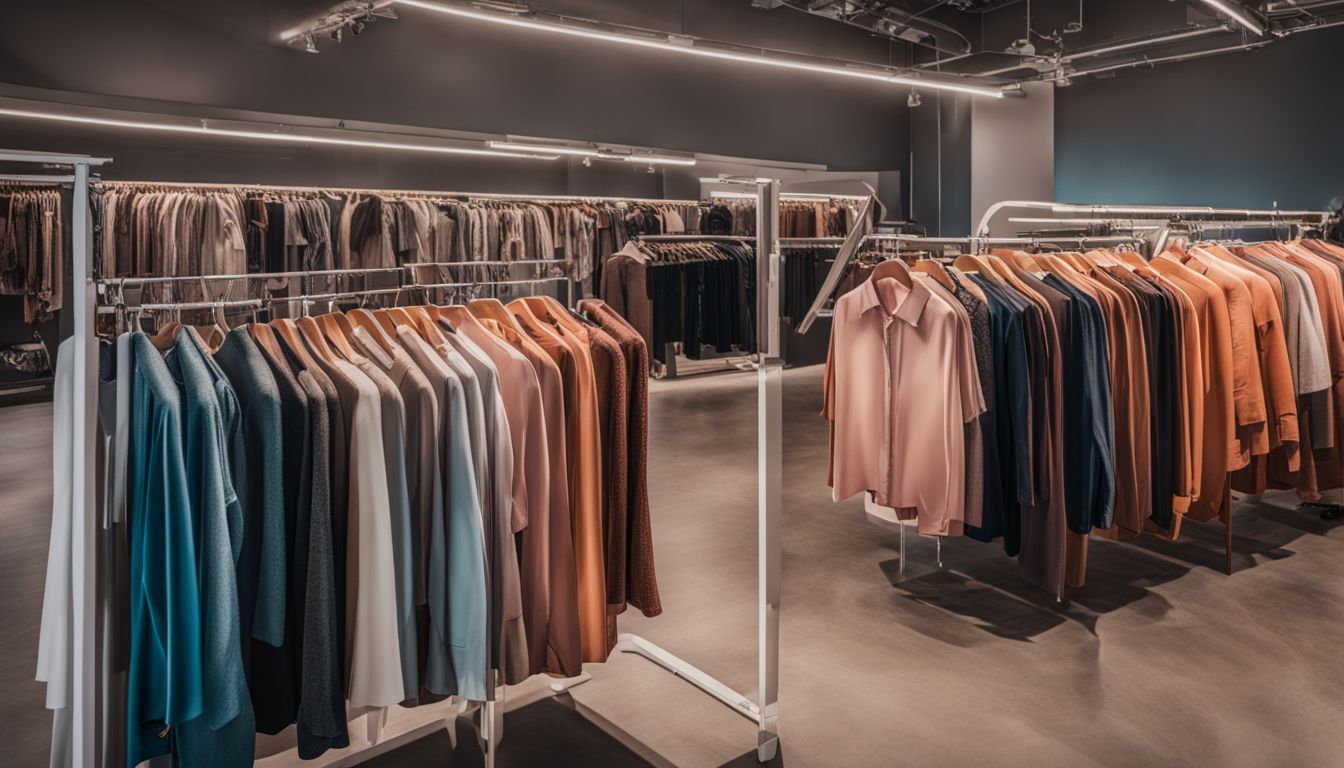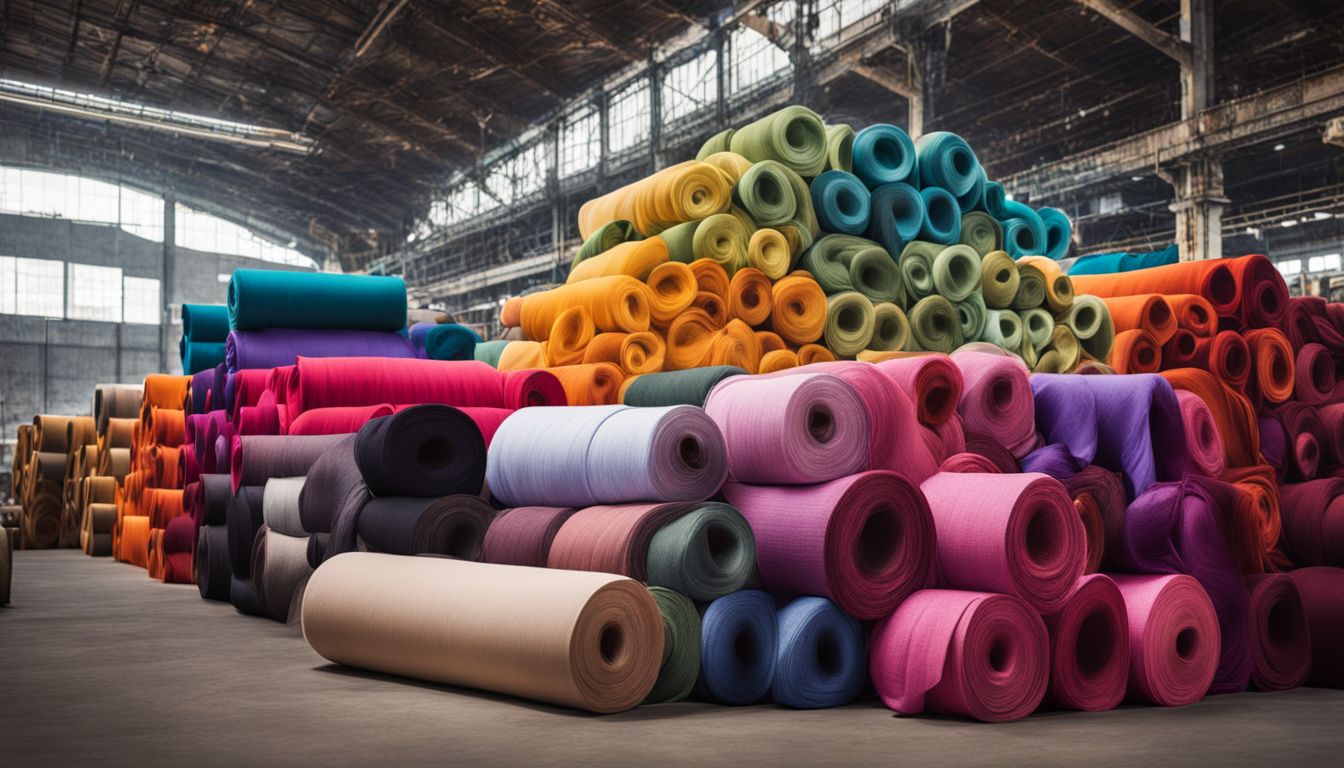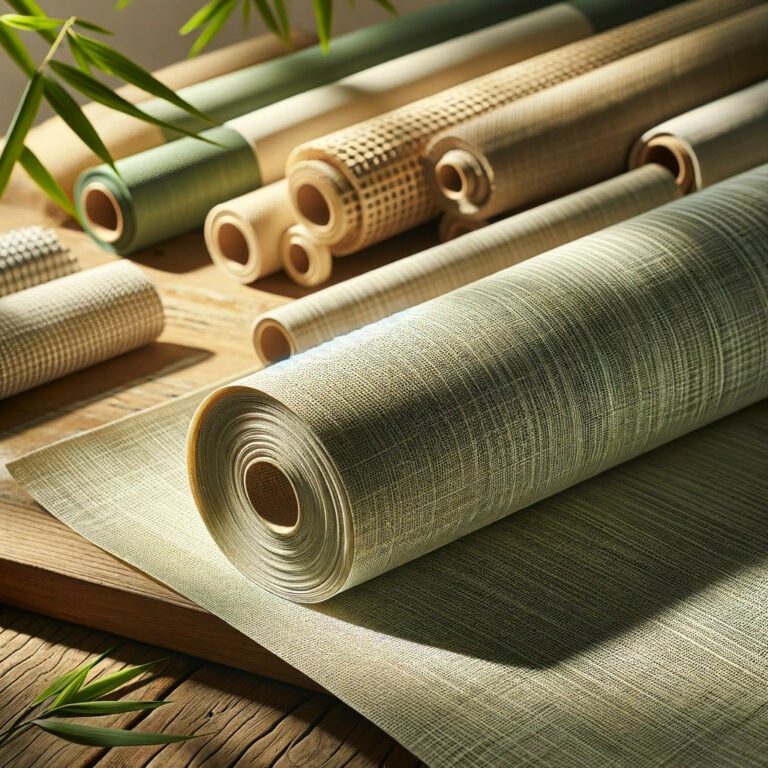Lyocell Fabric: Discover the Sustainable and Skin-friendly Benefits
Looking for a sustainable fabric that’s gentle on your skin and the environment? Fact is, Lyocell fabric offers just that, setting itself apart in the world of eco-friendly textiles.
This article will guide you through the sustainability factors, benefits and drawbacks of Lyocell, providing necessary insights to help make informed choices. And trust us when we say it gets even more fascinating as you delve deeper into this green textile innovation!
Key Takeaways
- Lyocell fabric is a sustainable choice made from renewable sources like eucalyptus and bamboo.
- It has a lower environmental impact compared to other textiles, using less water, energy, and chemicals in production.
- Lyocell fabric is soft, breathable, hypoallergenic, and moisture – wicking.
- It is versatile and durable, suitable for various clothing items.
What is Lyocell Fabric and How is it Made?

Lyocell fabric is a type of sustainable fabric made from cellulose fibers, typically derived from trees like eucalyptus or bamboo. The production process involves dissolving the cellulose in a non-toxic solvent and then spinning it into fibers, which are then woven into fabric.
The production process of Lyocell
The making of Lyocell fabric is a neat task. It starts with wood chips. Most often these chips come from trees like eucalyptus or bamboo. These trees grow fast and need little water.
Sources of Lyocell fibers
Lyocell fibers are derived from cellulose, which is obtained from various sources such as eucalyptus and bamboo. These natural materials serve as the starting point for creating Lyocell fabric through a production process that involves dissolving the cellulose in a solvent and then spinning it into fibers.
The use of sustainable sources like eucalyptus and bamboo helps to reduce the environmental impact of Lyocell production. By utilizing renewable resources, Lyocell fabric contributes to a more eco-friendly textile industry.
Environmental Impact of Lyocell Fabric
Lyocell fabric is known for its sustainable qualities, with a lower environmental impact compared to other textiles. Its production process requires less water and energy consumption, while also minimizing chemical usage and waste.
Additionally, Lyocell fabric is biodegradable and can be disposed of in an eco-friendly manner.
Sustainability of Lyocell

Lyocell fabric is considered to be a sustainable choice for clothing. It is made from cellulose, which comes from renewable sources like eucalyptus and bamboo. Unlike traditional cotton, the production of Lyocell uses less water and energy.
It also involves fewer chemicals and creates less waste. At the end of its life cycle, Lyocell fabric can be recycled or composted, making it an environmentally friendly option. Overall, Lyocell contributes to a more sustainable textile industry by reducing its environmental footprint and supporting the circular economy.
Water and energy consumption in production

The production of Lyocell fabric requires less water and energy compared to other fabrics like cotton or polyester. This makes it a more sustainable choice. The closed-loop system used in the production process allows for efficient use and recycling of water and chemicals.
Additionally, the manufacturing process of Lyocell fabric consumes less energy, contributing to reduced environmental impact. These factors make Lyocell fabric an environmentally friendly option with lower water and energy consumption during production.
Chemical usage and waste

Lyocell fabric is made using a closed-loop production process that minimizes chemical usage and waste. Unlike other fabrics, lyocell doesn’t require harmful chemicals like chlorine bleach to be processed.
Instead, non-toxic solvents are used, which can be recycled and reused in the manufacturing process. This reduces both the environmental impact and the amount of waste generated. Additionally, because lyocell fibers are derived from natural sources like wood pulp, they have a lower carbon footprint compared to synthetic fabrics like polyester.
So not only is lyocell fabric environmentally friendly during its production, but it also helps reduce overall chemical usage and waste in the textile industry.
Disposal and biodegradability
Lyocell fabric is not only sustainable during its production and use but also at the end of its life. When disposed of, lyocell fabric is biodegradable, meaning it can break down naturally in the environment without causing harm.
It is even compostable, which means it can be added to a compost pile or facility where it will decompose into nutrient-rich soil. This makes lyocell fabric an environmentally friendly choice that supports the principles of circular economy and reduces waste.
Advantages of Lyocell Fabric
Lyocell fabric offers numerous advantages, including being soft and breathable, moisture-wicking, hypoallergenic and gentle on the skin, versatile and durable. To learn more about the sustainability of Lyocell fabric and its environmental impact, read on!
Soft and breathable

Lyocell fabric is known for its softness and breathability, making it a comfortable choice for clothing. Unlike synthetic materials like polyester, which can trap heat and moisture, lyocell allows air to flow through the fabric, keeping you cool and dry.
This makes it especially ideal for activewear and summer clothing. Additionally, its soft texture feels gentle on the skin, making it suitable for people with sensitive skin or allergies.
The natural fibers of lyocell also make it hypoallergenic and resistant to bacteria buildup. So not only does it feel great against your skin, but it also helps keep you fresh throughout the day!
Moisture-wicking

Lyocell fabric is known for its moisture-wicking properties, which means it can absorb and release moisture quickly. This makes it a great choice for activewear and clothing that needs to keep you dry during physical activity or in hot weather.
Unlike synthetic fabrics like polyester, Lyocell allows your skin to breathe by transporting sweat away from the body. It also helps to prevent bacteria growth, keeping you feeling fresh and odor-free.
So whether you’re working out or just going about your day, Lyocell fabric will help keep you cool, comfortable, and dry.
Hypoallergenic and gentle on skin
Lyocell fabric is hypoallergenic, meaning it’s less likely to cause allergic reactions or skin irritations. This makes it a great choice for people with sensitive skin or allergies.
The fabric has a smooth and soft texture, which feels gentle against the skin. Unlike some synthetic materials, Lyocell does not trap moisture next to the skin, reducing the chance of bacterial growth and odors.
Whether you have delicate skin or just prefer fabrics that are kind to your body, Lyocell is a great option.
Versatile and durable

Lyocell fabric is not only sustainable but also versatile and durable. It can be used to make a wide range of clothing items, from dresses and shirts to jeans and activewear. Its strength allows it to withstand regular wear and tear, making it a long-lasting option for consumers.
Additionally, Lyocell fabric has excellent draping properties, which means it can easily adapt to different cuts and styles without losing its shape. This versatility makes it a popular choice among fashion designers who value both functionality and sustainability in their creations.
Renewable and biodegradable

Lyocell fabric is not only soft and durable but also renewable and biodegradable. It is made from wood fibers sourced from sustainable plants like eucalyptus and bamboo. Unlike synthetic materials, Lyocell can be fully composted at the end of its life cycle, reducing environmental waste.
Additionally, it can be reused multiple times before reaching this stage. By choosing Lyocell fabric, you are choosing a sustainable option that helps to minimize your environmental footprint.
Disadvantages of Lyocell Fabric

– Cost and availability can be limiting factors, but the benefits make it worth considering. Read more to learn about other drawbacks and their solutions.
Cost and availability

Lyocell fabric can be more expensive than some other fabrics due to the production process involved. However, as sustainable fashion becomes increasingly popular, the availability of lyocell fabric is also rising.
More brands are incorporating lyocell into their collections, making it easier for consumers to find and purchase products made from this eco-friendly material. Additionally, as lyocell is derived from renewable sources such as eucalyptus and bamboo, its availability is not limited by concerns over resource depletion.
Limited color options

Lyocell fabric, despite its many advantages, does have some limitations. One of these limitations is that it offers limited color options compared to other fabrics. While Lyocell can be dyed and colored, the process is more challenging due to its natural composition and structure.
This means that when shopping for Lyocell clothing or textiles, you may find a narrower range of colors available compared to synthetic fabrics like polyester. However, it’s important to remember that this limitation shouldn’t overshadow the numerous benefits and sustainable qualities of Lyocell fabric overall.
Prone to wrinkles and shrinkage
Lyocell fabric, while being sustainable and versatile, is prone to wrinkles and shrinkage. This means that it may require more care and maintenance compared to other fabrics. However, it’s important to note that not all Lyocell fabrics are equally prone to these issues.
Some brands have developed special techniques to minimize wrinkling and shrinking tendencies in their Lyocell products. Despite this drawback, the many advantages of Lyocell fabric, such as its softness, breathability, and eco-friendly nature make it a popular choice for sustainable fashion enthusiasts.
Care and maintenance requirements
To care for Lyocell fabric, it is best to follow the washing instructions on the garment’s label. Generally, Lyocell can be machine washed in cold or lukewarm water using a gentle cycle.
Avoid using bleach or harsh detergents as they can damage the fabric and affect its sustainability. It is recommended to air-dry Lyocell clothes instead of using a dryer, as high heat can cause shrinkage.
Ironing should be done at a low temperature. With proper care, Lyocell fabric can maintain its quality and durability over time.
Lyocell garments also have certain maintenance requirements to prolong their lifespan and sustainability. To prevent wrinkling, it is advisable to hang or fold them neatly after each use.
Storing Lyocell items in a cool and dry place will help preserve their condition. If any stains occur, it is important to treat them promptly with mild stain removers or by gently dabbing with a damp cloth.
Prominent Brands Using Lyocell Fabric

Sustainable fashion brands are increasingly incorporating Lyocell fabric in their collections, showcasing the commitment to environmentally friendly production.
Sustainable fashion brands incorporating Lyocell
Sustainable fashion brands are using Lyocell fabric in their products because it is eco-friendly and sustainable. Some prominent brands include:
- Levi’s: Levi’s has committed to using more sustainable materials in their jeans, including Lyocell fabric made from renewable sources.
- Patagonia: Patagonia is known for its environmentally-conscious practices, and they use Lyocell fabric in their clothing to reduce their environmental footprint.
- Eileen Fisher: Eileen Fisher prioritizes sustainability and ethical manufacturing. They incorporate Lyocell fabric into their designs for its natural origins and low environmental impact.
- H&M Conscious Collection: H&M’s Conscious Collection features clothing made from sustainable materials like Lyocell fabric, promoting a circular economy and reducing waste.
- Stella McCartney: As a pioneer of sustainable fashion, Stella McCartney incorporates Lyocell fabric into her designs for its eco-friendly production process and biodegradability.
Examples of brands and their commitment to sustainability
- Patagonia: A well-known outdoor clothing brand, Patagonia is committed to sustainability and uses Lyocell fabric in some of its products. They prioritize reducing their environmental impact by using renewable materials and implementing recycling programs.
- Eileen Fisher: Eileen Fisher is a fashion brand that focuses on sustainable practices. They use Lyocell fabric in their clothing line, which aims to be environmentally friendly and socially responsible.
- Reformation: Reformation is a sustainable fashion brand that uses Lyocell fabric in many of its designs. They prioritize transparency in their supply chain and strive to minimize waste in their production process.
- Amour Vert: Amour Vert is a brand that aims to create sustainable fashion without sacrificing style. They utilize Lyocell fabric for its eco-friendly properties and promote conscious consumerism.
- Alternative Apparel: Alternative Apparel is a clothing brand that values sustainability and ethical manufacturing practices. They incorporate Lyocell fabric into their collections to offer eco-friendly options for consumers.
Remember, these are just a few examples of brands committed to sustainability and incorporating Lyocell fabric into their products. Many other companies are also adopting eco-friendly practices and utilizing this sustainable material in their collections.
Conclusion

In conclusion, Lyocell fabric offers numerous advantages in terms of sustainability, comfort, and durability. It is made from renewable sources, has a low environmental footprint, and is biodegradable at the end of its life cycle.
However, there are also some disadvantages to consider, such as limited color options and care requirements. Overall, Lyocell fabric provides a promising alternative to traditional fabrics with its eco-friendly properties.
FAQs
1. What are the advantages of using lyocell fabric?
Lyocell fabric has many advantages, including its softness, breathability, moisture-wicking properties, and resistance to wrinkles.
2. Are there any disadvantages to using lyocell fabric?
One potential disadvantage of using lyocell fabric is that it can be more expensive compared to other types of fabrics. Additionally, some people may find it less durable than certain synthetic fibers.
3. How does lyocell fabric impact the environment?
Lyocell fabric is considered to be a sustainable choice because it is made from renewable materials like wood pulp and uses an environmentally friendly production process with minimal chemical waste and water usage.
4. Can I recycle or compost lyocell fabric?
Yes, you can recycle or compost lyocell fabric as it is biodegradable and non-toxic. However, make sure to check local recycling guidelines for proper disposal methods in your area.







